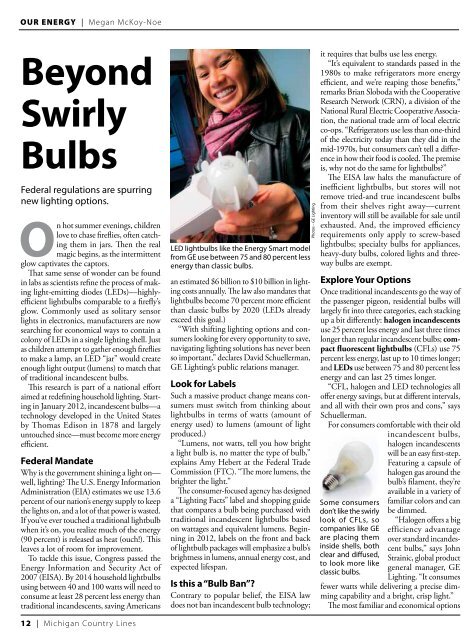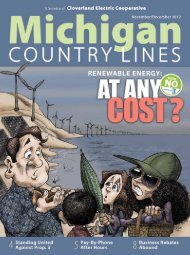Cherryland Electric Cooperative - Michigan Country Lines Magazine
Cherryland Electric Cooperative - Michigan Country Lines Magazine
Cherryland Electric Cooperative - Michigan Country Lines Magazine
You also want an ePaper? Increase the reach of your titles
YUMPU automatically turns print PDFs into web optimized ePapers that Google loves.
OUR ENERGY | Megan McKoy-Noe<br />
Beyond<br />
Swirly<br />
Bulbs<br />
Federal regulations are spurring<br />
new lighting options.<br />
On hot summer evenings, children<br />
love to chase fireflies, often catching<br />
them in jars. Then the real<br />
magic begins, as the intermittent<br />
glow captivates the captors.<br />
That same sense of wonder can be found<br />
in labs as scientists refine the process of making<br />
light-emitting diodes (LEDs)—highlyefficient<br />
lightbulbs comparable to a firefly’s<br />
glow. Commonly used as solitary sensor<br />
lights in electronics, manufacturers are now<br />
searching for economical ways to contain a<br />
colony of LEDs in a single lighting shell. Just<br />
as children attempt to gather enough fireflies<br />
to make a lamp, an LED “jar” would create<br />
enough light output (lumens) to match that<br />
of traditional incandescent bulbs.<br />
This research is part of a national effort<br />
aimed at redefining household lighting. Starting<br />
in January 2012, incandescent bulbs—a<br />
technology developed in the United States<br />
by Thomas Edison in 1878 and largely<br />
untouched since—must become more energy<br />
efficient.<br />
Federal Mandate<br />
Why is the government shining a light on—<br />
well, lighting? The U.S. Energy Information<br />
Administration (EIA) estimates we use 13.6<br />
percent of our nation’s energy supply to keep<br />
the lights on, and a lot of that power is wasted.<br />
If you’ve ever touched a traditional lightbulb<br />
when it’s on, you realize much of the energy<br />
(90 percent) is released as heat (ouch!). This<br />
leaves a lot of room for improvement.<br />
To tackle this issue, Congress passed the<br />
Energy Information and Security Act of<br />
2007 (EISA). By 2014 household lightbulbs<br />
using between 40 and 100 watts will need to<br />
consume at least 28 percent less energy than<br />
traditional incandescents, saving Americans<br />
LED lightbulbs like the Energy Smart model<br />
from GE use between 75 and 80 percent less<br />
energy than classic bulbs.<br />
an estimated $6 billion to $10 billion in lighting<br />
costs annually. The law also mandates that<br />
lightbulbs become 70 percent more efficient<br />
than classic bulbs by 2020 (LEDs already<br />
exceed this goal.)<br />
“With shifting lighting options and consumers<br />
looking for every opportunity to save,<br />
navigating lighting solutions has never been<br />
so important,” declares David Schuellerman,<br />
GE Lighting’s public relations manager.<br />
Look for Labels<br />
Such a massive product change means consumers<br />
must switch from thinking about<br />
lightbulbs in terms of watts (amount of<br />
energy used) to lumens (amount of light<br />
produced.)<br />
“Lumens, not watts, tell you how bright<br />
a light bulb is, no matter the type of bulb,”<br />
explains Amy Hebert at the Federal Trade<br />
Commission (FTC). “The more lumens, the<br />
brighter the light.”<br />
The consumer-focused agency has designed<br />
a “Lighting Facts” label and shopping guide<br />
that compares a bulb being purchased with<br />
traditional incandescent lightbulbs based<br />
on wattages and equivalent lumens. Beginning<br />
in 2012, labels on the front and back<br />
of lightbulb packages will emphasize a bulb’s<br />
brightness in lumens, annual energy cost, and<br />
expected lifespan.<br />
Is this a “Bulb Ban”?<br />
Contrary to popular belief, the EISA law<br />
does not ban incandescent bulb technology;<br />
Photos – GE Lighting<br />
it requires that bulbs use less energy.<br />
“It’s equivalent to standards passed in the<br />
1980s to make refrigerators more energy<br />
efficient, and we’re reaping those benefits,”<br />
remarks Brian Sloboda with the <strong>Cooperative</strong><br />
Research Network (CRN), a division of the<br />
National Rural <strong>Electric</strong> <strong>Cooperative</strong> Association,<br />
the national trade arm of local electric<br />
co-ops. “Refrigerators use less than one-third<br />
of the electricity today than they did in the<br />
mid-1970s, but consumers can’t tell a difference<br />
in how their food is cooled. The premise<br />
is, why not do the same for lightbulbs?”<br />
The EISA law halts the manufacture of<br />
inefficient lightbulbs, but stores will not<br />
remove tried-and true incandescent bulbs<br />
from their shelves right away—current<br />
inventory will still be available for sale until<br />
exhausted. And, the improved efficiency<br />
requirements only apply to screw-based<br />
lightbulbs; specialty bulbs for appliances,<br />
heavy-duty bulbs, colored lights and threeway<br />
bulbs are exempt.<br />
Explore Your Options<br />
Once traditional incandescents go the way of<br />
the passenger pigeon, residential bulbs will<br />
largely fit into three categories, each stacking<br />
up a bit differently: halogen incandescents<br />
use 25 percent less energy and last three times<br />
longer than regular incandescent bulbs; compact<br />
fluorescent lightbulbs (CFLs) use 75<br />
percent less energy, last up to 10 times longer;<br />
and LEDs use between 75 and 80 percent less<br />
energy and can last 25 times longer.<br />
“CFL, halogen and LED technologies all<br />
offer energy savings, but at different intervals,<br />
and all with their own pros and cons,” says<br />
Schuellerman.<br />
For consumers comfortable with their old<br />
incandescent bulbs,<br />
halogen incandescents<br />
will be an easy first-step.<br />
Featuring a capsule of<br />
halogen gas around the<br />
bulb’s filament, they’re<br />
Some consumers<br />
don’t like the swirly<br />
look of CFLs, so<br />
companies like GE<br />
are placing them<br />
inside shells, both<br />
clear and diffused,<br />
to look more like<br />
classic bulbs.<br />
available in a variety of<br />
familiar colors and can<br />
be dimmed.<br />
“Halogen offers a big<br />
efficiency advantage<br />
over standard incandescent<br />
bulbs,” says John<br />
Strainic, global product<br />
general manager, GE<br />
Lighting. “It consumes<br />
fewer watts while delivering a precise dimming<br />
capability and a bright, crisp light.”<br />
The most familiar and economical options<br />
12 | <strong>Michigan</strong> <strong>Country</strong> <strong>Lines</strong>

















